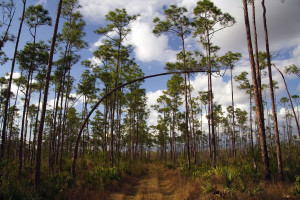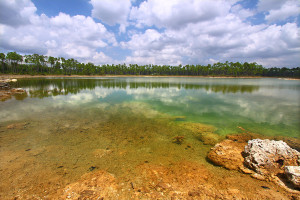The Pine Rocklands,  also called the Pinelands, are a disappearing habitat in the Everglades and all South Florida. These rocklands are found on limestone substrates. These Pinelands once covered around 185,000 acres in Miami-Dade County, and by 1996 only 2 percent of this forest remained in the urbanized areas of the county and outside the border of the Everglades National Park. The Florida Fish and Wildlife Conservation Commission (FWC) has recently proposed a list of four more plants in the Florida pine rockland ecosystem to receive federal protection. Three at risk species include: The Everglades bully, the Florida pineland crabgrass, and the pineland sandmat; one species is being considered as endangered: the Florida prairie-clover.
also called the Pinelands, are a disappearing habitat in the Everglades and all South Florida. These rocklands are found on limestone substrates. These Pinelands once covered around 185,000 acres in Miami-Dade County, and by 1996 only 2 percent of this forest remained in the urbanized areas of the county and outside the border of the Everglades National Park. The Florida Fish and Wildlife Conservation Commission (FWC) has recently proposed a list of four more plants in the Florida pine rockland ecosystem to receive federal protection. Three at risk species include: The Everglades bully, the Florida pineland crabgrass, and the pineland sandmat; one species is being considered as endangered: the Florida prairie-clover.
According to the Southeast regional director of the FWC, these four plants have declined by 80 percent in the last two decades. The primary threats these plants are facing are habitat loss and modification from sea-level rise, wildfires, and urban development. However, the pine rockland ecosystem is well adapted to fire that helps it survive better in the presence of fire that isn’t too intense.
The Everglades bully, a tall shrub with white flowers, only exists in 10 populations; the Florida pineland crabgrass, a blue-green perennial grass, is only found in the park and preserve; the pineland sandmat, a small perennial shrub, grows up to six feet, is found in the Big Cypress Preserve and 7 other locations in Miami-Dad county. The reason these plants have a high extinction risk is because the small populations have a limited to no chance for recolonization if hit by wildfires or extreme weather.
Hundreds of specials have been waiting for protection but these four are finally getting protection to survive and recover. It’s important to keep these plants alive and well as they help making up a nesting habitat for many species.
Visit the Disappearing Habitat
Although there are many efforts to save the Everglades, the area is still at high risk from disappearing from the Earth. The Everglades is a truly majestic place and needs to be seen in person for a person to fully embrace its beautiful. One great way to get a glimpse of the Everglades is on an airboat tour. To book a tour with Captain Mitch’s Airboat Tours, click here or call 800-368-0065.
 The Everglades is an internationally protected wilderness that hosts flora and fauna not found anywhere else in the world. Its diverse ecosystem weaves intricate webs of trees and marshes amid freshwater estuaries, all of which bleed into the Gulf of Mexico. There are nine habitats in the Everglades, and each plays an important role in the vitality of the area’s plants and animals. From swamps to pine forests, here’s what you can expect to find in each habitat, and which plant and wildlife can be found where:
The Everglades is an internationally protected wilderness that hosts flora and fauna not found anywhere else in the world. Its diverse ecosystem weaves intricate webs of trees and marshes amid freshwater estuaries, all of which bleed into the Gulf of Mexico. There are nine habitats in the Everglades, and each plays an important role in the vitality of the area’s plants and animals. From swamps to pine forests, here’s what you can expect to find in each habitat, and which plant and wildlife can be found where:





